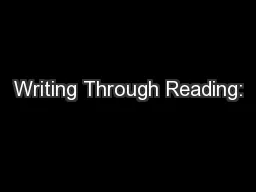PPT-Writing Through Reading:
Author : lindy-dunigan | Published Date : 2017-12-01
Bridging the Gap Lillie O Smith Reading Specialist K5 Literacy Leader Kristin Palmer Literacy Coach Hampton City Schools Presenters Lillie Smith is a Reading Specialist
Presentation Embed Code
Download Presentation
Download Presentation The PPT/PDF document "Writing Through Reading:" is the property of its rightful owner. Permission is granted to download and print the materials on this website for personal, non-commercial use only, and to display it on your personal computer provided you do not modify the materials and that you retain all copyright notices contained in the materials. By downloading content from our website, you accept the terms of this agreement.
Writing Through Reading:: Transcript
Download Rules Of Document
"Writing Through Reading:"The content belongs to its owner. You may download and print it for personal use, without modification, and keep all copyright notices. By downloading, you agree to these terms.
Related Documents


![[DOWNLOAD] - Subjects Matter, Second Edition: Exceeding Standards Through Powerful Content-Area](https://thumbs.docslides.com/901097/download-subjects-matter-second-edition-exceeding-standards-through-powerful-content-area-reading.jpg)
![[EPUB] - Teaching Science Through Inquiry-Based Instruction](https://thumbs.docslides.com/901267/epub-teaching-science-through-inquiry-based-instruction.jpg)
![[EPUB] - 180 Days of Writing for Second Grade - An Easy-to-Use Second Grade Writing Workbook](https://thumbs.docslides.com/901424/epub-180-days-of-writing-for-second-grade-an-easy-to-use-second-grade-writing-workbook-to-practice-and-improve-writing-skills.jpg)
![[EPUB] - Gifted Guild\'s Guide to Depth and Complexity: Finding Your Way Through the](https://thumbs.docslides.com/901492/epub-gifted-guild-s-guide-to-depth-and-complexity-finding-your-way-through-the-framework.jpg)
![[EPUB] - Mathematical Mindsets: Unleashing Students\' Potential through Creative Math,](https://thumbs.docslides.com/901627/epub-mathematical-mindsets-unleashing-students-potential-through-creative-math-inspiring-messages-and-innovative-teaching.jpg)
![[EBOOK] - Teaching Writing in Kindergarten: A Structured Approach to Daily Writing That](https://thumbs.docslides.com/901683/ebook-teaching-writing-in-kindergarten-a-structured-approach-to-daily-writing-that-helps-every-child-become-a-confident-capabl.jpg)
![[EBOOK] - 180 Days of Writing for First Grade - An Easy-to-Use First Grade Writing Workbook](https://thumbs.docslides.com/901798/ebook-180-days-of-writing-for-first-grade-an-easy-to-use-first-grade-writing-workbook-to-practice-and-improve-writing-skills.jpg)
![[DOWNLOAD] - But What If I Don\'t Want to Go to College?: A Guide to Success Through](https://thumbs.docslides.com/902120/download-but-what-if-i-don-t-want-to-go-to-college-a-guide-to-success-through-alternative-education.jpg)
![[EPUB] - Businesspeople Don\'t Like to Read, We Scan: A Quick, Strategic Guide for Effective](https://thumbs.docslides.com/902899/epub-businesspeople-don-t-like-to-read-we-scan-a-quick-strategic-guide-for-effective-business-writing-speaking-and-writing.jpg)
![[EBOOK] - LAUNCH: How to Get Your Kids Through College Debt-Free and Into Jobs They Love](https://thumbs.docslides.com/905040/ebook-launch-how-to-get-your-kids-through-college-debt-free-and-into-jobs-they-love-afterward.jpg)
![[DOWNLOAD] - The Creative Writing Student\'s Handbook (Creative Writing Matters Guides)](https://thumbs.docslides.com/905252/download-the-creative-writing-student-s-handbook-creative-writing-matters-guides.jpg)
![[READ] - The Only Writing Series You\'ll Ever Need - Grant Writing: A Complete Resource](https://thumbs.docslides.com/905612/read-the-only-writing-series-you-ll-ever-need-grant-writing-a-complete-resource-for-proposal-writers.jpg)
![[EPUB] - Encouraging Metacognition: Supporting Learners through Metacognitive Teaching](https://thumbs.docslides.com/907067/epub-encouraging-metacognition-supporting-learners-through-metacognitive-teaching-strategies-educational-psychology.jpg)